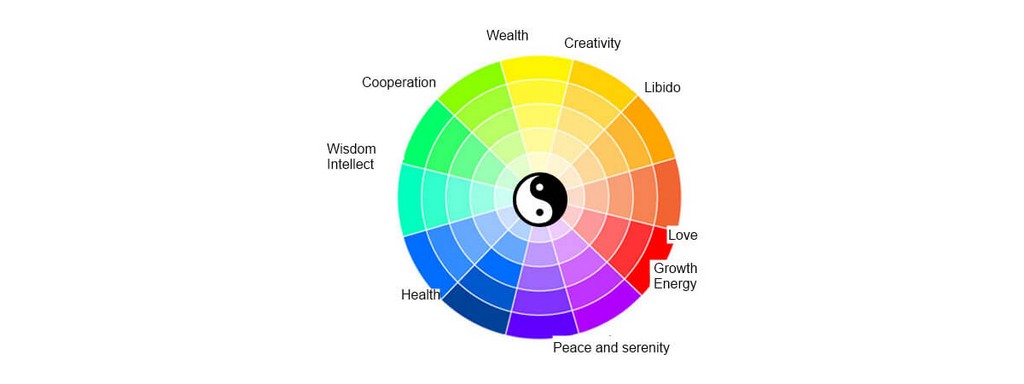Feng Shui School

According to Feng Shui, colours are divided into calming, cold yin colours like the colour blue, and warm, stimulating yang colours like the colour red.Similarly, contemporary psychology speaks of the influence of colours on people's moods, which is nowadays often used in interior design and colour selection for certain rooms.
Feng Shui - the ancient Chinese art of harmonizing space
Feng Shui is an ancient Chinese method of planning and decorating a space with the purpose of giving balance and prosperity to a home. Feng Shui has been used at least 4000 years ago, and some believe that it is over 6000 years old.The oldest archaeological evidence of it date from 5000 years ago.
Its original name Kan Yu (Chinese for “the study of the sky and earth”) was changed to Fend Shui (Chinese for “the study of wind and water”).
Originally, Feng Shui was used for decorating graves and burial grounds, so that the family of the deceased would be prosperous in generations to come.Later, by building upon the existing formulas and diagrams, the study was applied to the homes of the living.
Feng Shui’s main aim is to create a harmonious space which will have a positive impact on the occupants’ health, life, and work.
Feng Shui is linked with an ancient Chinese philosophy, which states that the whole universe is full of the chi energy, and it is manifested in the positive yang energy, and the negative yin energy, and they have to be in balance.Yin is the energy of the earth, the female principle, complex, and dark. Yang is the energy of the sky, the male principle, bright, and simple.These two opposites are in a dynamic balance.
Other than the layout of the furniture, colours are one of the most important tools Feng Shui experts use to direct chi, and change the energy of certain parts of your home.When colours match, they enable prosperity, love, and health. When used in the wrong way, the can yield the opposite effect.
Walls in different colours can instantly liven up a space, but the main problem is which colours to choose and how to combine them.If you are uncertain which colours would match your furniture or if you can’t decide between different shades, read some ancient Feng Shui tips.
Feng Shui is based on five elements - fire, metal, earth, wood, and water.Each element has its own colours, which have different effects on people.
Wood = green, blue
Wood represents energy of youth, health, and vitality.Green and brown objects bring those feelings to your home.Green is the colour of rebirth, regeneration and new energy.Feng Shui says that it keeps the body in balance by transferring positive natural vibrations.To use green to its greatest extent, use several shades at the same time.Brown contains nutritious Feng Shui energy, and has recently become a frequent choice for people decorating their homes.It should be placed to the east for it to bring health, or to the south-east to attract money.Used in the north-facing part of your home, it will attract fame.
Fire = red, orange
Fire represents passion, energy, and initiative, and it is linked with red, orange, and pink.North, north-east, and south-west rooms of your apartment or house are ideal for those colours.Red represents the qualities of fire the best.Bright red colour gives the energy of joy and excitement, andfans the flames of sexual desire.It is ideal for bedrooms.If red is too strong for you, orange is a great alternative.Orange is a social colour, because it gives energy for interesting conversations, sparks optimism, and encourages openness.Feng Shui experts say that purple should be used in moderation.
Purple should be present in your home on various objects, rather than on walls.Pink is the universal colour of love, so it is a great choice for softening up energy in a certain space.It is considered to be calming, and it can be used in any room.
Earth = yellow
Earth represents stability, diligence, and perseverance, and its colours are beige, light yellow and sand.The colours of the earth should be placed in the central part of the apartment, the north-east, and south-west.Yellow brightens up a space, be it your home or your office.All shades of yellow can bring an energy of cosiness to the kitchen or children’s room.
Metal = white, grey, beige, silver
Metal is associated with management, and precision. In the world of colours it is represented by white and grey.White symbolizes purity and innocence.White also contains all other colours, so it is welcome in all variants, but not in excess.If you want a creative environment, use grey in the west-facing parts of your home, and if you want to attract people who can be of help to you, use it in the north-west.If you want to advance your career, use grey in the west part of your home or office.
Water = dark blue, black
Water is the source of wisdom, intelligence, peace, and freshness, and its colours are blue and black.
Blue can be used on walls or objects in the north part of the home to advance your career, in the east for health, and in the south-east for money.Black gives depth, strength and definition to every space.
Of course, it shouldn’t be used in the children’s room or the bedroom ceiling.

Feng Shui divides colours into calming and cool yin colours, such as blue, and warm and encouraging yang colours, such as red.Modern psychology deals with the influence of colours on our mood in a similar way, and this approach is widely used in interior decorating.
The basic yin colour is blue, and it creates a sense of peacefulness, and the basic yang colour is red, with an encouraging effect on the human psyche.Purple is also one of the basic yin colours, and orange is considered a yang colour.Located between them are neutral colours such as yellow and green, whose impact on our emotions depends on the colours we mix them with.If we mix them with blue, we will get cooler shades of turquoise or icy yellow.If we mix them with red, we will get warmer shades of peach or grass.
Green
Relaxes the eyes, encourages creativity, growth and regeneration, represents new beginnings, healing, freshness, and hope - suitable for a study.
Red
Stimulates appetite, is beneficial for the metabolism, acts as a stimulator, and gives energy, but can also cause nervousness - should be used on details in the living room or kitchen
Yellow
Encourages communication and interactions with our surroundings, symbolizes strength, health, patience, and wisdom - suitable for the living room
Pink and purple
Have a calming effect and symbolize unconditional love, romance, and partnership - suitable for the bedroom or meditation room.
Purple encourages spirituality, adventure, and prosperity.
Brown
Symbolizes stability, warmth and peace, offers safety
White
Symbolizes purity and simplicity, clarity, precision, and communication
Blue
Has a calming effect, and is beneficial for thinking and studying - lighter shades of blue can be used in the bedroom
Black
Used with caution, and in small amounts.
A contemplative colour which encourages thinking, and feelings of mystery.
Not recommended when decorating a home, only on small details.
Grey
A refined colour, symbolizes nobleness, encourages helping, and represents a harmonious mix of black and white.
Orange
A cheerful colour which encourages happiness.
Blue-green
Represents youth and new beginnings, fills us with confidence
Dark blue
Encourages wisdom and introspection
The kitchen
The dining room and the kitchen should be in warm, lighter colours, such as salmon or peach.
These colours will stimulate your appetite in moderation.Metal is associated with white, beige, and silver.All these colours are suitable for the kitchen, because we associate them with cleanliness (which is necessary when preparing food).Besides, metal is compatible with fire, a dominant element in the kitchen.The floors should be in earthen tones, and the walls in warm pastel tones of vanilla or peach.
The living room
The earthen colour yellow encourages communication and openness towards other people, so various warm variants of yellow are suitable for decorating your living room.Red is the colour of the fire element.Red stimulates your appetite and metabolism, but can also encourage aggression.If you are a fan of red, choose some lighter shades, or use it only on details in the living room and kitchen. This will liven up the space, but won’t seem too aggressive.
The bedroom
The water element’s colours are dark blue and black.Blue is calming, but also encourages to think about life, and the world around us.Lighter shades of blue are suitable for the bedroom.You can also use equally calming lavender or olive tones.Vibrant red should not be used in the bedroom because it can have negative effects on your sleep, but details like red pillows can spark up passion in the right moment.Purple has calming properties on the human psyche, so it it often used in meditation rooms, and it is also suitable for bedrooms.
The bathroom
White purifies the space. To avoid a sterile and boring look, add some warmer shades.
The study
Green is associated with the wood element. It calms the eyes, which makes it suitable for the study or a space where you usually read or store books.
If you paint your walls in natural earthy tones, all colours and details will pop thanks to that neutral background.
Neutral tones of beige work perfectly with organic materials such as wood, stone, or reed.
They reflect light, which makes the room seem bigger.
Black absorbs all colours, and Feng Shui considers it to be the ultimate yin.Black represents darkness, and can stimulate fear, depression, and aggression. It is not recommended to use it, except on small details.

Before applying the Feng Shui principles, remove all unnecessary items from your space.
Keeping the space tidy helps you feel organized and at peace.Always have a way for fresh air to come in, as well as sunlight, because it attracts positive energy.Balance and harmony are the basic rules of Feng Shui.Chaos and imbalance are Feng Shui’s biggest enemies.A house not properly decorated or messy weakens the aura of the interior and stops positive energy from coming in.The biggestblockages for good Feng Shui are cluttered entrance hallways, so it is best to start with them.After that, you can move on to other rooms of your house, and help them breathe once again.
Broken appliances or other gadgets are an obstacle to vitality.Get rid of scratched trays, burned-out light bulbs, and all clothing items which have been damaged by moths.Fix clocks, unclog your drains, tighten loose chairs, and hinges on your closet doors.In other words, fix or replace everything that you can.
Windows are the eyes of a home, and the front door are its mouth.In order to make your home look tidy and clean, and bring clarity and peace to yourself, keep your windows and doors clean, and make sure that the function properly.
The Bagua map is used to position rooms and items in them.
Entrance
Chi enters the home through the front door.That’s why they are the starting point for decorating your home using the Feng Shui principles, and you have to give them special attention.There should be no clutter on either sides of the door. The door should be big, in good condition, clean, and easy to open.If chi can enter a home freely, it will help you in getting a job.The placement of furniture dictates how energy will flow around a room.When chi gets in, it should be able to move freely.
The living room
The central part of the left side of an apartment or house symbolizes community and socialization, sothe living room should be there.The living room should have enough light, and be spacious and tidy.
The furniture should not disrupt the flow of chi, so it should be bright, light, and comfortable.Since this room is mainly for relaxing and socializing with guests, the living room presents the inhabitants at their best.If you want to emphasize something, the farthest wall is ideal for that.Details, diplomas, or an attractive colour are a great way to divert attention.Bookshelves should never be full, because people get the impression that you lack the desire for spiritual growth.
Kitchen and dining room
The kitchen should be located in the south-east corner, and its shape should be as simple as possible. The ceiling should not be too high or too low.The stove is traditionally viewed as the symbol of family wealth, so the look of the kitchen is very important in Feng Shui.The kitchen should have good lighting, and be clean and functional.The stove and microwave oven should be noticeable.
Plants symbolize the need for socializing and making new friends, and trees represent growth and stability, which can help finances.A waterfall, fountain, or aquarium can help with your career.
The dining room is of great importance, because it is the space in which household members eat together.If it is in accordance with Feng Shui, it can help strengthen their relationship.
It should be located in the centre of the home, near the kitchen, and as far away from the front door as possible.Mirrors in the dining room are also welcome, because the make the space seem bigger, and the food duplicated, which contributes to our well-being.
The bedroom
The bedroom should be given attention if we want our romantic relationship to progress.The bedroom should be as far away from the front door as possible.The position of the bed is mostimportant. It should face the door, but not be placed directly opposite them.There is no universal formula on how to place items - you should decorate the space according to your own wishes.
If you want to encourage bonding with other people, separate the bed from the walls. If you lack stability in your life, place the wall next to a wall.The headboard should be on a firm and decorated wall.Something pleasant should be opposite the headboard - a window, a photograph you hold dear, or a painting which brings out positive emotions.The bedroom should not have mirrors.An electrical socket near your head can cause bad dreams.

FIRE
red purple
power - wealth - abundance
FIRE
power - wealth - abundance

FIRE
red orange
glory - future - reputation
FIRE
glory - future - reputation

FIRE
red pink
love - marriage - love
FIRE
love - marriage - love

TREE
green
family - health - community
TREE
family - health - community

GROUND
yellow brown
wellbeing - balance
GROUND
wellbeing - balance

METAL
gray metallic white
creativity - children - law
METAL
creativity - children - law

METAL
gray metallic white
compassion - help - travel
METAL
compassion - help - travel

WATER
blue black
career - work - self-confidence
WATER
career - work - self-confidence

WATER
blue black
knowledge - wisdom - harmoniy
WATER
knowledge - wisdom - harmoniy
